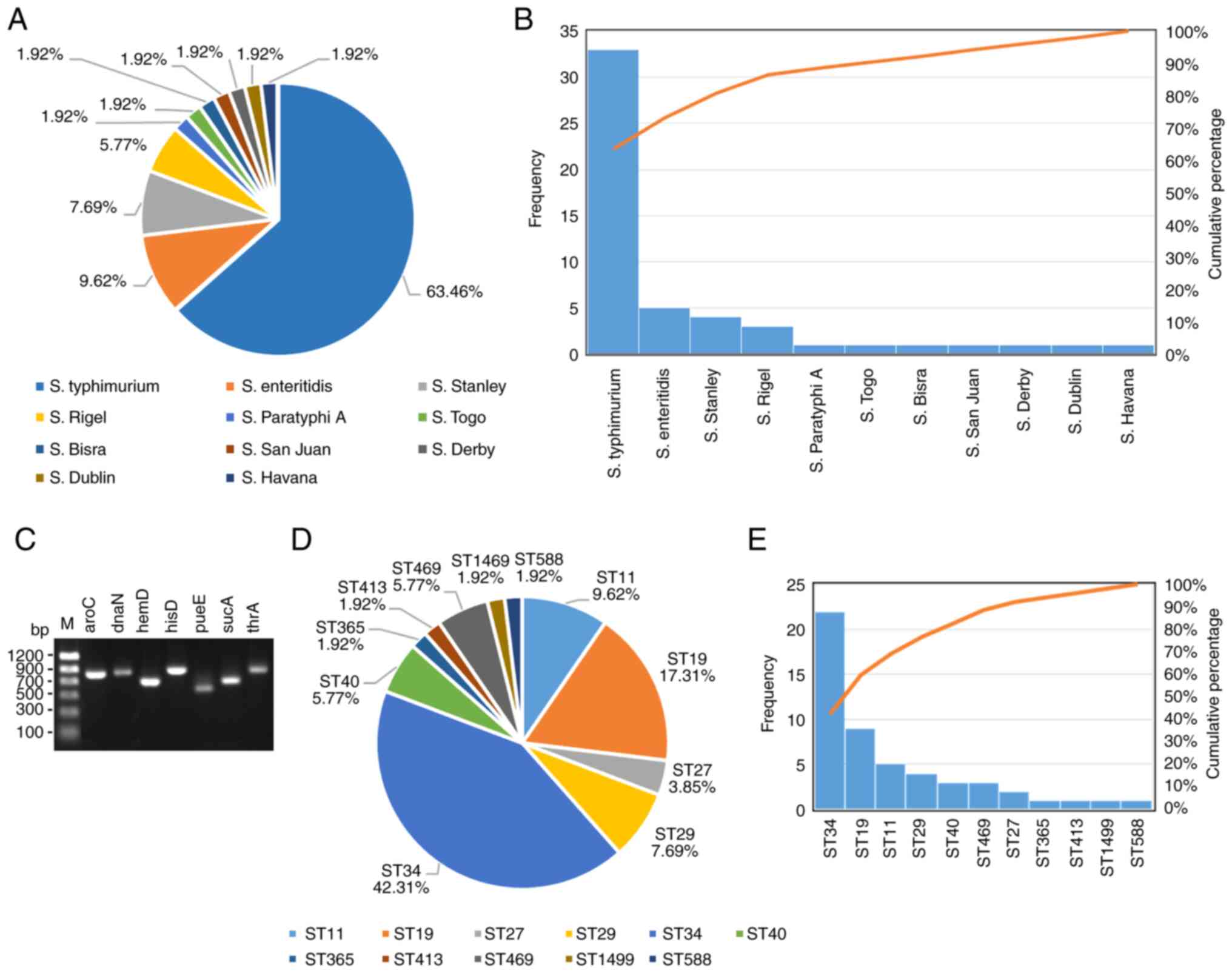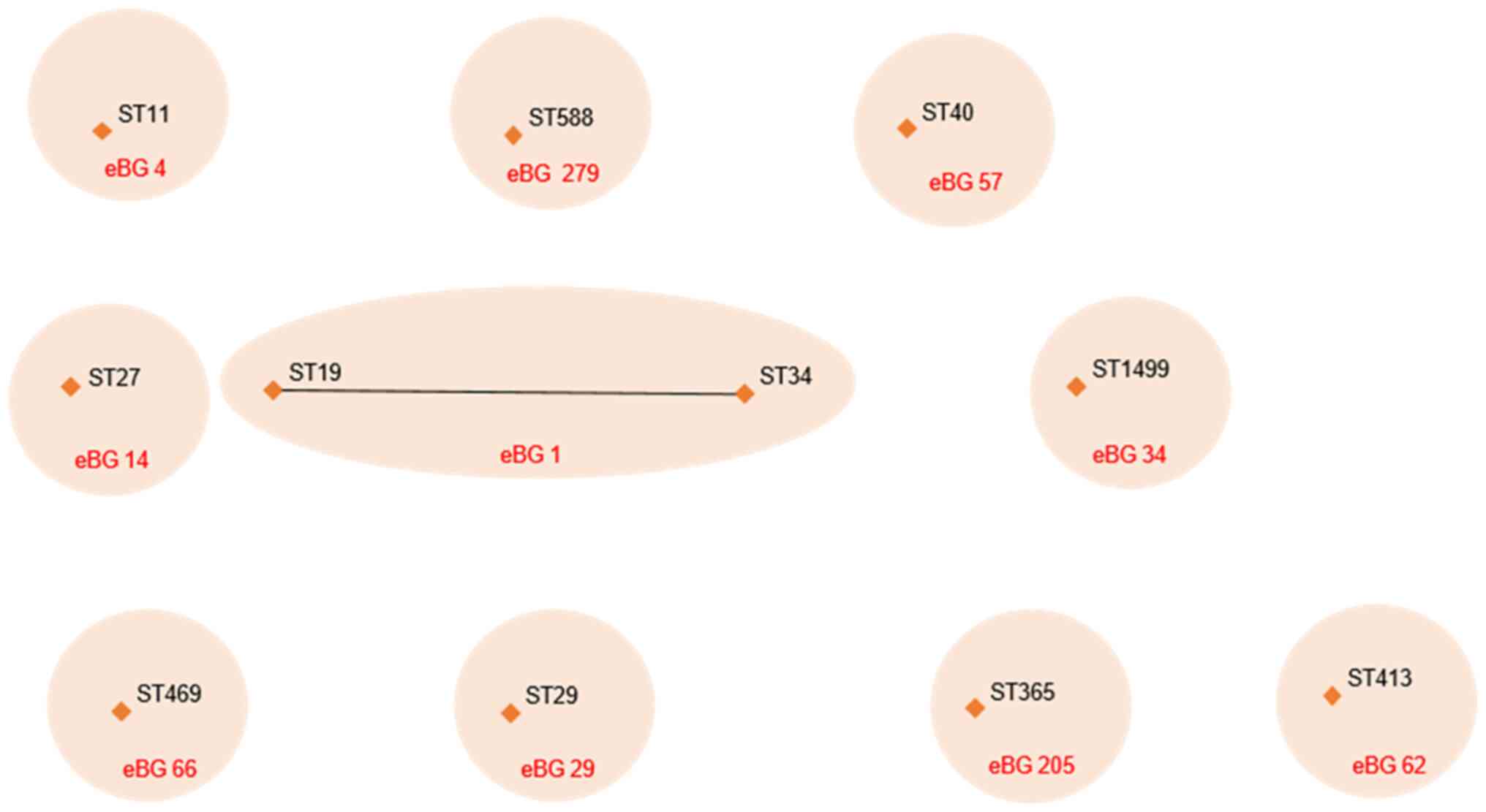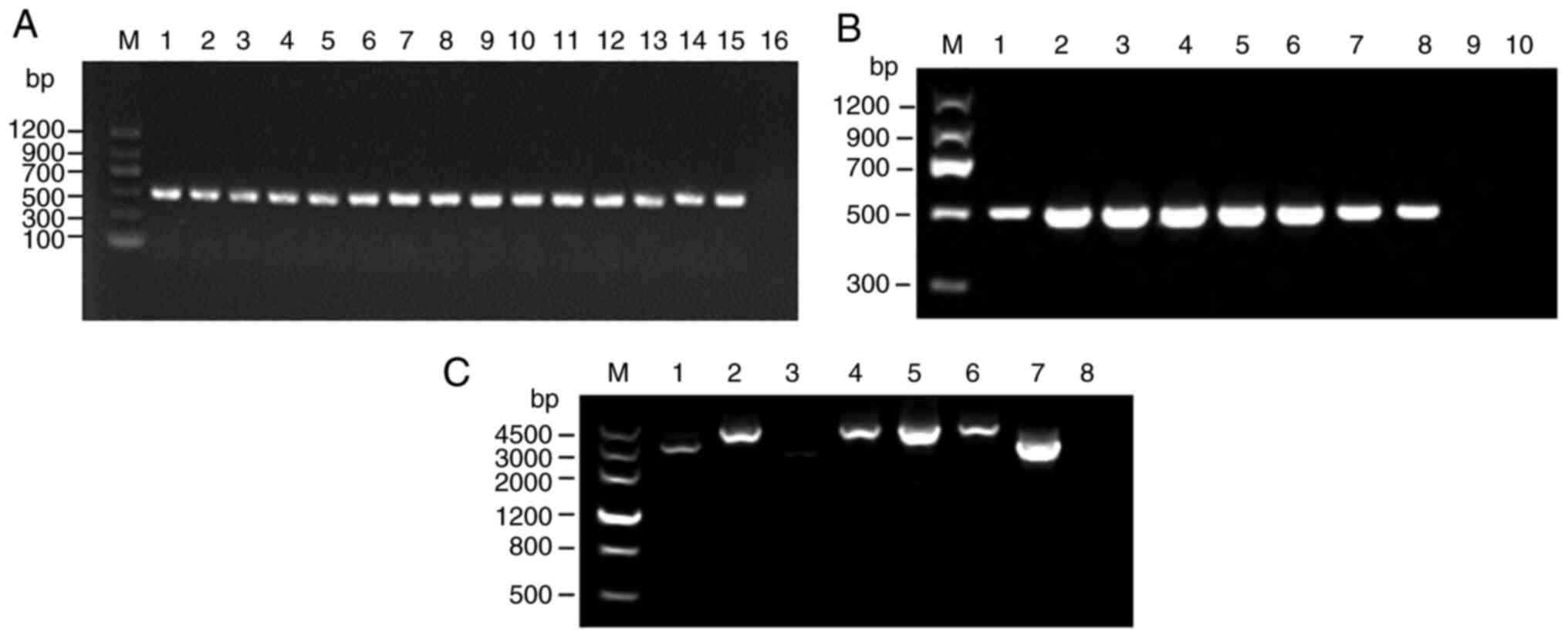|
1
|
El-Tayeb MA, Ibrahim ASS, Al-Salamah AA,
Almaary KS and Elbadawi YB: Prevalence, serotyping and
antimicrobials resistance mechanism of Salmonella enterica isolated
from clinical and environmental samples in Saudi Arabia. Braz J
Microbiol. 48:499–508. 2017.PubMed/NCBI View Article : Google Scholar
|
|
2
|
Chen HM, Wang Y, Su LH and Chiu CH:
Nontyphoid salmonella infection: Microbiology, clinical features,
and antimicrobial therapy. Pediatr Neonatol. 54:147–152.
2013.PubMed/NCBI View Article : Google Scholar
|
|
3
|
Jajere SM: A review of Salmonella enterica
with particular focus on the pathogenicity and virulence factors,
host specificity and antimicrobial resistance including multidrug
resistance. Vet World. 12:504–521. 2019.PubMed/NCBI View Article : Google Scholar
|
|
4
|
Jackson BR, Griffin PM, Cole D, Walsh KA
and Chai SJ: Outbreak-associated Salmonella enterica serotypes and
food Commodities, United States, 1998-2008. Emerg Infect Dis.
19:1239–1244. 2013.PubMed/NCBI View Article : Google Scholar
|
|
5
|
Guo L and Zhao Y: Global spread and
molecular characterization of CTX-M-producing salmonella
typhimurium isolates. Antibiotics (Basel). 10(1417)2021.PubMed/NCBI View Article : Google Scholar
|
|
6
|
Darini AL, Magalhaes VD, Levy CL, Barth AL
and Coscina AL: Phenotyping and genotyping methods applied to
investigate the relatedness of Brazilian isolates of Enterobacter
cloacae. Braz J Med Biol Res. 32:1077–1081. 1999.PubMed/NCBI View Article : Google Scholar
|
|
7
|
Yan S, Zhang W, Li C, Liu X, Zhu L, Chen L
and Yang B: Serotyping, MLST, and Core Genome MLST Analysis of
salmonella enterica from different sources in China During
2004-2019. Front Microbiol. 12(688614)2021.PubMed/NCBI View Article : Google Scholar
|
|
8
|
Ferrari RG, Panzenhagen PHN and
Conte-Junior CA: Phenotypic and genotypic eligible methods for
salmonella typhimurium source tracking. Front Microbiol.
8(2587)2017.PubMed/NCBI View Article : Google Scholar
|
|
9
|
Edwards PR and Kauffmann F: A
simplification of the Kauffmann-White schema. Am J Clin Pathol.
22:692–697. 1952.PubMed/NCBI View Article : Google Scholar
|
|
10
|
Ziebell K, Chui L, King R, Johnson S,
Boerlin P and Johnson RP: Subtyping of Canadian isolates of
salmonella enteritidis using multiple locus variable number tandem
repeat analysis (MLVA) alone and in combination with pulsed-field
gel electrophoresis (PFGE) and phage typing. J Microbiol Meth.
139:29–36. 2017.PubMed/NCBI View Article : Google Scholar
|
|
11
|
Kotetishvili M, Stine OC, Kreger A, Morris
JG Jr and Sulakvelidze A: Multilocus sequence typing for
characterization of clinical and environmental salmonella strains.
J Clin Microbiol. 40:1626–1635. 2002.PubMed/NCBI View Article : Google Scholar
|
|
12
|
Maiden MC, Bygraves JA, Feil E, Morelli G,
Russell JE, Urwin R, Zhang Q, Zhou J, Zurth K, Caugant DA, et al:
Multilocus sequence typing: A portable approach to the
identification of clones within populations of pathogenic
microorganisms. Proc Natl Acad Sci USA. 95:3140–3145.
1998.PubMed/NCBI View Article : Google Scholar
|
|
13
|
Achtman M, Wain J, Weill FX, Nair S, Zhou
Z, Sangal V, Krauland MG, Hale JL, Harbottle H, Uesbeck A, et al:
Multilocus sequence typing as a replacement for serotyping in
Salmonella enterica. PLoS Pathog. 8(e1002776)2012.PubMed/NCBI View Article : Google Scholar
|
|
14
|
Kidgell C, Reichard U, Wain J, Linz B,
Torpdahl M, Dougan G and Achtman M: Salmonella typhi, the causative
agent of typhoid fever, is approximately 50,000 years old. Infect
Genet Evol. 2:39–45. 2002.PubMed/NCBI View Article : Google Scholar
|
|
15
|
Gugala N, Vu D, Parkins MD and Turner RJ:
Specificity in the susceptibilities of escherichia coli,
pseudomonas aeruginosa and staphylococcus aureus clinical isolates
to six metal antimicrobials. Antibiotics (Basel).
8(51)2019.PubMed/NCBI View Article : Google Scholar
|
|
16
|
Firoozeh F, Mahluji Z, Khorshidi A and
Zibaei M: Molecular characterization of class 1, 2 and 3 integrons
in clinical multi-drug resistant Klebsiella pneumoniae isolates.
Antimicrob Resist Infect Control. 8(59)2019.PubMed/NCBI View Article : Google Scholar
|
|
17
|
Cui M, Zhang J, Gu Z, Li R, Chan EW, Yan
M, Wu C, Xu X and Chen S: Prevalence and molecular characterization
of mcr-1-positive Salmonella strains recovered from clinical
Specimens in China. Antimicrob Agents Chemother. 61:e02471–16.
2017.PubMed/NCBI View Article : Google Scholar
|
|
18
|
Bell RL, Gonzalez-Escalona N, Stones R and
Brown EW: Phylogenetic evaluation of the ‘Typhimurium’ complex of
Salmonella strains using a seven-gene multi-locus sequence
analysis. Infect Genet Evol. 11:83–91. 2011.PubMed/NCBI View Article : Google Scholar
|
|
19
|
Machado E, Canton R, Baquero F, Galán JC,
Rollán A, Peixe L and Coque TM: Integron content of
extended-spectrum-beta-lactamase-producing Escherichia coli strains
over 12 years in a single hospital in Madrid, Spain. Antimicrob
Agents Chemother. 49:1823–1829. 2005.PubMed/NCBI View Article : Google Scholar
|
|
20
|
Feil EJ, Li BC, Aanensen DM, Hanage WP and
Spratt BG: eBURST: Inferring patterns of evolutionary descent among
clusters of related bacterial genotypes from multilocus sequence
typing data. J Bacteriol. 186:1518–1530. 2004.PubMed/NCBI View Article : Google Scholar
|
|
21
|
Spratt BG, Hanage WP, Li B, Aanensen DM
and Feil EJ: Displaying the relatedness among isolates of bacterial
species-the eBURST approach. FEMS Microbiol Lett. 241:129–134.
2004.PubMed/NCBI View Article : Google Scholar
|
|
22
|
Uzzau S, Brown DJ, Wallis T, Rubino S,
Leori G, Bernard S, Casadesús J, Platt DJ and Olsen JE: Host
adapted serotypes of Salmonella enterica. Epidemiol Infect.
125:229–255. 2000.PubMed/NCBI View Article : Google Scholar
|
|
23
|
Kuang X, Hao H, Dai M, Wang Y, Ahmad I,
Liu Z and Zonghui Y: Serotypes and antimicrobial susceptibility of
Salmonella spp. isolated from farm animals in China. Front
Microbiol. 6(602)2015.PubMed/NCBI View Article : Google Scholar
|
|
24
|
Li WW, Bai L, Zhang XL, Qiao X, Yang XR,
Chen YZ, Pei XY, Wu YN and Guo YC: Prevalence and antibiogram
distribution of Salmonella isolated from broiler production and
processing course in four provinces, China. Zhonghua Yu Fang Yi Xue
Za Zhi. 47:435–438. 2013.PubMed/NCBI(In Chinese).
|
|
25
|
Majowicz SE, Musto J, Scallan E, Angulo
FJ, Kirk M, O'Brien SJ, Jones TF, Fazil A and Hoekstra RM:
International Collaboration on Enteric Disease ‘Burden of Illness’
Studies. The global burden of nontyphoidal Salmonella
gastroenteritis. Clin Infect Dis. 50:882–889. 2010.PubMed/NCBI View Article : Google Scholar
|
|
26
|
Wu LJ, Luo Y, Shi GL and Li ZY:
Prevalence, clinical characteristics and changes of antibiotic
resistance in children with nontyphoidal Salmonella infections from
2009-2018 in Chongqing, China. Infect Drug Resist. 14:1403–1413.
2021.PubMed/NCBI View Article : Google Scholar
|
|
27
|
Who PY, Yeung MPS, Nelson EAS and Goggins
WBI: Risk factors of non-typhoidal Salmonella gastroenteritis in
hospitalised young children: A case-control study. BMJ Paediatr
Open. 5(e000898)2021.PubMed/NCBI View Article : Google Scholar
|
|
28
|
Ugboko HU, Nwinyi OC, Oranusi SU and
Oyewale JO: Childhood diarrhoeal diseases in developing countries.
Heliyon. 6(e03690)2020.PubMed/NCBI View Article : Google Scholar
|
|
29
|
Gong B, Li H, Feng Y, Zeng S, Zhuo Z, Luo
J, Chen X and Li X: Prevalence, serotype distribution and
antimicrobial resistance of non-typhoidal Salmonella in
hospitalized patients in Conghua District of Guangzhou, China.
Front Cell Infect Microbiol. 12(805384)2022.PubMed/NCBI View Article : Google Scholar
|
|
30
|
Burns-Guydish SM, Olomu IN, Zhao H, Wong
RJ, Stevenson DK and Contag CH: Monitoring age-related
susceptibility of young mice to oral Salmonella enterica serovar
Typhimurium infection using an in vivo murine model. Pediatr Res.
58:153–158. 2005.PubMed/NCBI View Article : Google Scholar
|
|
31
|
Angarone M and Snydman DR: AST ID
Community of Practice. Diagnosis and management of diarrhea in
solid-organ transplant recipients: Guidelines from the American
Society of Transplantation Infectious Diseases Community of
Practice. Clin Transplant. 33(e13550)2019.PubMed/NCBI View Article : Google Scholar
|
|
32
|
Patel K and Goldman JL: Safety concerns
surrounding quinolone use in children. J Clin Pharmacol.
56:1060–1075. 2016.PubMed/NCBI View Article : Google Scholar
|
|
33
|
Al Kraiem AA, Yang G, Al Kraiem F and Chen
T: Challenges associated with ceftriaxone resistance in Salmonella.
Front Life Sci. 11:26–34. 2018.
|
|
34
|
Song Q, Xu Z, Gao H and Zhang D: Overview
of the development of quinolone resistance in Salmonella species in
China, 2005-2016. Infect Drug Resist. 11:267–274. 2018.PubMed/NCBI View Article : Google Scholar
|
|
35
|
Hall RM, Brookes DE and Stokes HW:
Site-specific insertion of genes into integrons: Role of the
59-base element and determination of the recombination cross-over
point. Mol Microbiol. 5:1941–1959. 1991.PubMed/NCBI View Article : Google Scholar
|
|
36
|
Stokes HW and Hall RM: A novel family of
potentially mobile DNA elements encoding site-specific
gene-integration functions: Integrons. Mol Microbiol. 3:1669–1683.
1989.PubMed/NCBI View Article : Google Scholar
|
|
37
|
Cornaglia G, Giamarellou H and Rossolini
GM: Metallo-β-lactamases: A last frontier for β-lactams? Lancet
Infect Dis. 11:381–393. 2011.PubMed/NCBI View Article : Google Scholar
|
|
38
|
Fluit AC and Schmitz FJ: Resistance
integrons and super-integrons. Clin Microbiol Infect. 10:272–288.
2004.PubMed/NCBI View Article : Google Scholar
|
|
39
|
Liu CC, Tang CY, Chang KC, Kuo HY and Liou
ML: A comparative study of class 1 integrons in Acinetobacter
baumannii. Gene. 544:75–82. 2014.PubMed/NCBI View Article : Google Scholar
|
|
40
|
Wu K, Wang F, Sun J, Wang Q, Chen Q, Yu S
and Rui Y: Class 1 integron gene cassettes in multidrug-resistant
Gram-negative bacteria in southern China. Int J Antimicrob Agents.
40:264–267. 2012.PubMed/NCBI View Article : Google Scholar
|
|
41
|
Vo AT, van Duijkeren E, Gaastra W and
Fluit AC: Antimicrobial resistance, class 1 integrons, and genomic
island 1 in Salmonella isolates from Vietnam. PLoS One.
5(e9440)2010.PubMed/NCBI View Article : Google Scholar
|
|
42
|
Lu Y, Zhao H, Sun J, Liu Y, Zhou X, Beier
RC, Wu G and Hou X: Characterization of multidrug-resistant
Salmonella enterica serovars Indiana and Enteritidis from chickens
in Eastern China. PLoS One. 9(e96050)2014.PubMed/NCBI View Article : Google Scholar
|
|
43
|
Zhao X, Hu M, Zhang Q, Zhao C, Zhang Y, Li
L, Qi J, Luo Y, Zhou D and Liu Y: Characterization of integrons and
antimicrobial resistance in Salmonella from broilers in Shandong,
China. Poult Sci. 99:7046–7054. 2020.PubMed/NCBI View Article : Google Scholar
|
|
44
|
Yang J, Ju Z, Yang Y, Zhao X, Jiang Z and
Sun S: Serotype, antimicrobial susceptibility and genotype profiles
of Salmonella isolated from duck farms and a slaughterhouse in
Shandong province, China. BMC Microbiol. 19(202)2019.PubMed/NCBI View Article : Google Scholar
|
|
45
|
Zhao X, Yang J, Zhang B, Sun S and Chang
W: Characterization of integrons and resistance genes in Salmonella
isolates from farm animals in Shandong province, China. Front
Microbiol. 8(1300)2017.PubMed/NCBI View Article : Google Scholar
|
|
46
|
Zhang H, Shi L, Li L, Guo S, Zhang X,
Yamasaki S, Miyoshi S and Shinoda S: Identification and
characterization of class 1 integron resistance gene cassettes
among Salmonella strains isolated from healthy humans in China.
Microbiol Immunol. 48:639–645. 2004.PubMed/NCBI View Article : Google Scholar
|
|
47
|
Bagheri-Nesami M, Rezai MS, Ahangarkani F,
Rafiei A, Nikkhah A, Eslami G, Shafahi K, Hajalibeig A and Khajavi
R: Multidrug and co-resistance patterns of non-fermenting
Gram-negative bacilli involved in ventilator-associated pneumonia
carrying class 1 integron in the North of Iran. Germs. 7:123–131.
2017.PubMed/NCBI View Article : Google Scholar
|
|
48
|
Gu B, Tong M and Zhao W, Liu G, Ning M,
Pan S and Zhao W: Prevalence and characterization of class I
integrons among Pseudomonas aeruginosa and Acinetobacter baumannii
isolates from patients in Nanjing, China. J Clin Microbiol.
45:241–243. 2007.PubMed/NCBI View Article : Google Scholar
|
|
49
|
Deng Y, Bao XR, Ji L, Chen L, Liu J, Miao
J, Chen D, Bian H, Li Y and Yu G: Resistance integrons: Class 1, 2
and 3 integrons. Ann Clin Microbiol Antimicrob.
14(45)2015.PubMed/NCBI View Article : Google Scholar
|
|
50
|
Prestinaci F, Pezzotti P and Pantosti A:
Antimicrobial resistance: A global multifaceted phenomenon. Pathog
Glob Health. 109:309–318. 2015.PubMed/NCBI View Article : Google Scholar
|
|
51
|
Harbottle H, White DG, McDermott PF,
Walker RD and Zhao S: Comparison of multilocus sequence typing,
pulsed-field gel electrophoresis, and antimicrobial susceptibility
typing for characterization of Salmonella enterica serotype Newport
isolates. J Clin Microbiol. 44:2449–2457. 2006.PubMed/NCBI View Article : Google Scholar
|
|
52
|
Sun J, Ke B, Huang Y, He D, Li X, Liang Z
and Ke C: The molecular epidemiological characteristics and genetic
diversity of salmonella typhimurium in Guangdong, China, 2007-2011.
PLoS One. 9(e113145)2014.PubMed/NCBI View Article : Google Scholar
|
|
53
|
Gu W, Yang Z, Chen Y, Yin J, Yang J, Li C,
Zhou Y, Yin J, Xu W, Zhao S, et al: Molecular characteristics of
Salmonella enterica Paratyphi A in Yunnan Province, southwest
China. Infect Genet Evol. 30:181–185. 2015.PubMed/NCBI View Article : Google Scholar
|
|
54
|
Xu F, Wang T, Tan H, Li M, Jin Y and Guo
H: The multilocus sequence typing and drug resistance
characteristics of Salmonella in children with diarrhea. J Clin
Pediatr. 36:520–523. 2018.PubMed/NCBI View Article : Google Scholar : (In Chinese).
|


















